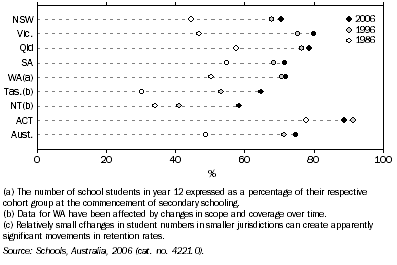SCHOOLS
At February 2007, there were 59,970 students attending ACT schools. Of these, 35,020 (58.4%) were attending the 88 government schools (including one primary school operating in Jervis Bay Territory). The remaining 24,950 (41.6%) were attending the 44 non-government schools.
The number of students attending schools in the ACT has declined by 0.5% (305 students) since 2005, with primary school enrolments declining the most (down 1.1% since 2005). This reflects the ageing of the ACT population. In contrast, the number of college students has increased slightly (up 0.9%, or 88 students).
Consistent with the structure of the ACT population, there tend to be slightly more males than females in each of the school education sectors (primary, high, college and special), in both government and non-government schools.
Preschools
At February 2007, there were 3,499 children enrolled at 79 ACT government mainstream preschools and five Koori preschools. Since some Indigenous children attend more than one preschool, this equates to 3,520 enrolments, an increase of 4.5% (151 enrolments) on February 2006
School sectors
At February 2007, just over half (51%) of all school students attended primary school, comprising 15,562 males and 15,106 females. In comparison, 32% of students attended high school (9,948 males and 9,499 females) and 16% attended a college (4,801 males and 4,716 females).
Special school enrolments refer to students with intellectual and physical disabilities, or students who require additional emotional and/or behavioural assistance who are attending special schools. They do not include special students who are attending other schools. In February 2007, there were 338 students attending special schools, comprising 222 males and 116 females.
Government and non-government schools
More students attended government schools than non-government schools at every level of school education. At February 2007, 61% of primary school students and 63% of college students attended government schools or colleges. The high school sector was more evenly split, with 51% of all high school students attending government schools.
6.1 School students enrolled, by sector and category of school, ACT - as at February |
|  |
 |  | Primary
school(a) | High
school | College | Special
school(b) | Total |  |
 |  | no. | no. | no. | no. | no. |  |
|  |
| Government |  |  |  |  |  |  |
 | 2005 | 19 241 | 10 237 | 5 903 | 340 | 35 721 |  |
 | 2006 | 19 033 | 10 095 | 6 013 | 322 | 35 463 |  |
 | 2007 | 18 686 | 9 998 | 5 998 | 338 | 35 020 |  |
| Non-government |  |  |  |  |  |  |
 | 2005 | 11 754 | 9 274 | 3 526 | - | 24 554 |  |
 | 2006 | 11 815 | 9 342 | 3 522 | - | 24 679 |  |
 | 2007 | 11 982 | 9 449 | 3 519 | - | 24 950 |  |
| Total |  |  |  |  |  |  |
 | 2005 | 30 995 | 19 511 | 9 429 | 340 | 60 275 |  |
 | 2006 | 30 848 | 19 437 | 9 535 | 322 | 60 142 |  |
 | 2007 | 30 668 | 19 447 | 9 517 | 338 | 59 970 |  |
|  |
| - nil or rounded to zero (including null cells) |
| (a) Includes the Jervis Bay School. |
| (b) Only includes students in special schools. |
| ACT Department of Education and Training: ACT Schools Census, February 2007, Government School Census Bulletin, February 2005 and February 2006, Non-Government Schools Census, February 2005 and February 2006. |
Apparent retention rate
The apparent retention rate for full-time school students is the percentage of full-time students in a designated year/level of education who continue to a particular year/level of education. It provides an indication of the proportion of students who continue on at school.
To calculate the 2006 apparent retention rate of full-time students at the Australia level, the total number of full-time students in Year 12 in 2006 is divided by the number of full-time students in the base year (Year 7 in NSW, Vic. and Tas and the ACT in 2001, and Year 8 in Qld, SA, WA and the NT in 2002). The base year represents the year of commencement of the secondary school systems in the respective state or territory.
Care should be exercised in the interpretation of apparent retention rates as the method of calculation does not take into account a range of factors. At the Australia level these include students repeating a year of education, migration and other net changes to the school population. At lower levels of disaggregation, additional factors affecting the data, such as enrolment policies (which contribute to different age/grade structures between states and territories), inter-sector transfer and interstate movements of students have not been taken into account. These and other factors affecting the interpretation of apparent retention rates are being addressed, where possible, in an ABS review of apparent retention rates.
The latest findings of the review were released in a research paper Deriving Measures of Engagement in Secondary Education from the National Schools Statistics Collection (cat. no. 1351.0.55.016), published in December 2006.
The ACT continues to record the highest apparent retention rates of any state or territory. At August 2006, the apparent retention rate of ACT full-time secondary students from Year 7/8 to Year 12 was 88.7%, 2.6 percentage points lower than that in 1996 (91.3%).
6.2 Apparent retention rates (a), Full-time secondary students
- Year 7/8 to Year 12
- 1996 and 2006

 Print Page
Print Page
 Print All
Print All
 Print Page
Print Page
 Print All
Print All